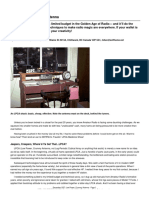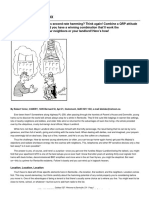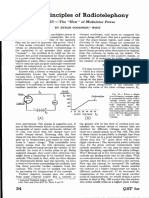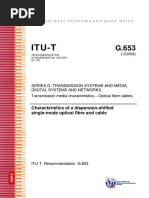0 ratings0% found this document useful (0 votes)
Arrl - QST Magazine - Principles of Radiotelephony - Part 2 (1954)
Arrl - QST Magazine - Principles of Radiotelephony - Part 2 (1954)
Uploaded by
Anonymous 60esBJZIjarrl - qst magazine - principles of radiotelephony - part 2 (1954)
Copyright:
© All Rights Reserved
Available Formats
Download as PDF or read online from Scribd
Download as pdf
Arrl - QST Magazine - Principles of Radiotelephony - Part 2 (1954)
Arrl - QST Magazine - Principles of Radiotelephony - Part 2 (1954)
Uploaded by
Anonymous 60esBJZIj0 ratings0% found this document useful (0 votes)
arrl - qst magazine - principles of radiotelephony - part 2 (1954)
Original Title
arrl - qst magazine - principles of radiotelephony - part 2 (1954)
Copyright
© © All Rights Reserved
Available Formats
PDF or read online from Scribd
Share this document
Did you find this document useful?
Is this content inappropriate?
arrl - qst magazine - principles of radiotelephony - part 2 (1954)
Copyright:
© All Rights Reserved
Available Formats
Download as PDF or read online from Scribd
Download as pdf
0 ratings0% found this document useful (0 votes)
Arrl - QST Magazine - Principles of Radiotelephony - Part 2 (1954)
Arrl - QST Magazine - Principles of Radiotelephony - Part 2 (1954)
Uploaded by
Anonymous 60esBJZIjarrl - qst magazine - principles of radiotelephony - part 2 (1954)
Copyright:
© All Rights Reserved
Available Formats
Download as PDF or read online from Scribd
Download as pdf
You are on page 1/ 4
Some Principles of Radiotelephony
Part II — Plain Talk About A.M. Fundamentals
BY BYRON GOODMAN, * WIDX
© Part I appeared in the May issue. Al-
though Part II is complete in itself, it is
highly recommended that Part I (and
‘Technical Topics in this issuc) be read
hefore the second installment. — ED.
Modulator Power
Apparently, one of the most confusing points
ubout a.m. radiotelephony is the neod for modu-
lator power. Since the Year 1 amateurs (and
commercials) have been looking for a means for
feeding a low-powered audio signal into a big
transmitter and getting out a husky ‘phono
signal. ‘They're still looking.
We can think of only two general clusses of
modulation systems, One would be where rf.
power fed into the modulated stage is controlled,
and the amount of rf. appearing in the output
is dependent upon the instantaneous value of
the modulating signal. This could be represented
as in Fig. 7A, and a typical example is a diode-
modulator circuit. ‘The modulated stage is not
an amplifier of any kind —it is simply a point
where rf. power from another source can be
controlled by a modulating signal.
‘The other general class of modulation system
would be one where @ modulated amplifier stage
is involved. Here a relatively small rf. signal is
amplified by the stage to deliver a large rf.
power output. Any such device will, of course,
have a d.c. power supply associated with it,
since the increased power must, come from some-
where, and the amplifier actually only transforms
the d.e. power into r. It docsn’t do this job
completely — some of the d.c. power is used up
by the stage in the process. A high-efficiency
amplifier might transform 75 per cent of the d.c.
power into ré. power, while an inefficient one
might deliver only 30 per cent. If the efficiency
of the modulated stage is constant over a given
range of d.c, input voltage, we ean modulate the
stage by using the modulating signal to control
the input voltage. This is illustrated in Fig. 7B.
Uf, however, the efficiency (and input current) of
the stage can be varied by the modulating signal,
then we can modulate the output by using the
audio signal to control the efficiency (and input
power) of the stage. This is illustrated in Fig. 7C.
‘The first example of a modulator, shown in
Fig. 7A, is seldom used except. at low power
levels, and is of little more than academic interest
in this discussion, The other two examples are
the ones commonly used in transmitters.
“+ Assistant Technical Raitor, QST.
June 1954
Let’s examine the example of Fig. 7B more
closely. Since we know (even without showing
an actual circuit) that the modulated amplifier
is taking d.c. power from the d.c. voltage source,
we can represent the amplifier by a resistance
capable of dissipating that power. Further, we
have agroed that the efficiency of the amplifier
is constant, so we also know that this resistance
iss constant one (not changing in some way
with applied voltage), or else the conirol of the
Modulated
Stage
RE Power Madulated
‘input —»——| |» Pomer
Output
(A) * BIE ten
se,
iy
Modulated Amplifier
Eticlency,
Moditated Aniplifier
: |» FPomer
Signal Outout
Gia De. Power
{Shire
AF
Hodatat +
otis 3
Fig. 7—Three possible methods for modulating «
radio signal,
(A) ‘The modulating signal controls the passage of
energy through the modulated stage, A. diode modu
lator otago isan example of such « method,
‘modulating signal varies the power input
to a constant-fliciency rf. amplifier.
(6) "The modalating signal varies the eficiency and
input current of a variable-efligieney r,f, amplifier.
13
input voltage by the modulating sigual must
also vary ina similar manner. While this might
be done, it would be au unnecessarily eompli-
cated system.
Thus we have 2 constant resistance, a dic.
source nnd aur u.c. source connected in series, as
in Fig. 8A. We have omitted any mention of r.f.
now because we know that the r.t. output voltage
is some constant percentage (the efficiency) of
R
Emod
th
Fac
(a)
—
vous Ema
“across +E
| Emin
Time
@)
Wig, 8— Fig, 7B looks like (A) above to the de.
power source and the modulating-signal source.
‘B) For 100 per cent modulation of the voltage ap-
ied to Rin (A), the applied voltage will vary with
time in this manner. Enrx and Enis represent the
voltage swings above and below the steady Ese.
the input voltage. Our problem is to find what
power, if any, must be furnished by the audio
souree, Med, for the maximum-permissible mod-
ulation percentage of 100.1
‘The d.c. source pute a voltage Hite ueross the
resistor J, und the audio source, Brot, also de-
velops its voltage across R. Maximum modula-
tion will occur when the voltage across 2 is
being swung up to a value equal to twice Bas
aud buck down to zero, as in Fig. SB. ‘This is
obvious, of course, and it can be secu that the
maximum and minimum peak swings, Bmax and
Brig, ure equal in value to Esc.
"To sce what all this means in the way of power
in B, let's first review what we mean by power.
Tn a de. circuit it is, of course, simply 2A or
Bt +R. I and # have steady’ values, so it's
easy to know what numbers to use. In an a.c.
circuit, it’s a little more complicated, because
the current or voltage is not constant but is
changing rapidly, as in any of the sinc-wave
representations we have showa so far.
In scientific circles, “power” is called the
“time rate of doing work.” It might be consid-
ered a spocial kind of average. ‘To illustrate this
double-talk, lot's look at Fig. 9
In Fig. YA, a resistor fis connected to 2
voltage source, Ha. We know that the current,
through the resistor is Hie + R, aud it will be
constant with time unless we change Hus or 2.
"Why tho msximum-permissible modulation percentage
in (00 was explained in Part I~ Ep,
14
Fig. JB shows a similar ease with an alternating
voltage source, Exc, und the problem is to find
at peak value of By, will do the same work a8
Eae's doing. Now the only work that the eurrrent
does in flowing through the resistor is to heat it,
so here is our common factor. We recall that the
power dissipated in the resistor for the d.c. enso,
and hence the power supplied by the d.c. souree,
is FR or BR.
We can draw a curve for this as in Fig. 9C.
When we try to do the same thing for the a.c.
cireuit, we're stumped. At least we are until wo
treat, each little period of time separately. Then
it ien’t, too difficult, All we have to do is to take
the value of eurrent at that instant, square it, und
inultiply by the resistance. When we do this we
get 2 new curve that looks like Fig. 9D. This
turns out to look like @ sine wave of twice the
frequency of the original. You could call this a
graph of the “instantaneous power" (but be
careful how you use that expression, “instan-
taneous power”). What we want to find is how
tho a.c, of Fig. 9B relates to the d.c. of Fig. 9A
when they both have the same heating effect on
R. It's obvious that if the frequency of the a.c.
were very low, the heat changes in R could be
deteetod if we were brave enough to touch the
resistance, but any a.c. we would be working
with would be of a frequoney high enough so
that the heat changes during a eyele wouldn't
be apparent. So at any practical frequency it
must reach an “average” of some kind. ‘The
mathematicians will tell you that the “aver-
age” of a curve like this ean be obtained by
taking the area under the curve (shown shaded)
or a given time interval and dividing it by the
ime. The answer is a singic value that, work-
ing over the sume time interval, would give the
same total area, But. the value of our power
for the dic. case is just the same thing — it is »
figure that, over a given time interval, xives the
area under the curve (shaded portion of Fig. 90).
You can tell by just looking at the two power
‘curves that the peal “instantaneous power” for
the ac, case is a high valuc compared with the
cc. ease.
Tt all works out, if you dive into the mathe-
matics of it, that an n.c, with a peak-to-peak
swing of 2.828 amperes bas tho same heating
effect as a ce. of 1.0 amperes. With a peak-to-
peak value of 2.828, the peak value is half of
this, or 144. If the peak value is 1.0, the dc.
equivalent value is 0.707. This dic. equivalent
value is called the “effective” or ‘rams
(root-mean-squared”) value ~ it’s what an
mmeter indicates for you, There ure devices
known 2s ‘peak meters” that can indicate peak
values for you— they're useful for measuring
sc. that ia made up of more than a pure single
frequeney, where the relationship betwoen peak
value and r.m.s, value is not known us it is in
this case.
Now let's get back to that modulator-power
requirement. Referring aguin to Fig. 8B, we can
recall that in this 100-per-ceut-modulation ease,
Fas = Eaux = Enix. With our new-found knowl-
OST for
edge about a.c., we see now that the effective
value of Emoa is 0.707 of the peak value, and
xince the peak value is Zmax (or Enix), the ef-
fective value of Hoa = 0.707 Bmax. Without
knowing about the a.c., we knew that the dc.
source Hj, was delivering power to the load Jt
that can be computed by
Power supplied by Hae
de. power
supplied,
Independent of this, the source Enea furnishes
power computed by
(0.707 E,
Power supplied by Broa =
Since Ene has the same value as Hye, we seo
that, in 2 constant-elliciency modulation circuit,
with 100 per cent sine-tave modulation, the modu-
lator must furnish power eal to one-half the d.c.
power supplied to the modulation eirouit.
‘There is one point you shouldn’t overlook.
We said nothing about the efficiency of the mod-
ulated stage except that it was coustant. It
might be only 40 per cent or it might be as high
as 75 per cent, but we would still need the same
amount of modulator power for 100 per cent
modulation. We need power to swing the voltage
around on the modulated stage, and there is no
way around it. Of course, if the modulation per-
centage is less, we will require less power from
the modulator. If the modulating signal is a
complex one, like voice, in which the rms.
value is lesa than 0.707 of the peak value, then
we will require less modulating power. But the
modulating-power source should be capable of
&
aio
©)
times
(B) An ac, gource and load R, with a plot of eurrent vs. time.
ease (C) and for the a.
Notice that each eyele in (B) gives tro eyeles in (D).
plot of 7 os ime for the a
w)
June 1954
(>
Fig. 9—(A) A dc. source and load K, with a plot of current rs.
delivering the power necessary for 100 per cont
modulation with a sine wave,
By now you're itching to ask about the other
modulation system, the one in which the efi-
ciency is varied by the modulating signal (Fig.
70). This looks like pay-dirt territory, beeaus.
conceivably the unnamed “ellicicney-control”
circuit has a high effective resistance, and it,
won't tale much modulator power to swing it all
over somebody’s half acre. Quite true, Such
cireuits ean be made in which the modulating
voltage can be developed across’a high resistance
and the power involved is low (control-grid
modulation is an example). But you still pay a
price. For a starting point, remetber that we
must swing the efficiency up and down about
mean level. It is obvious that the maximum
eficieney that we can swing up to is the maxi-
mum the tube is capable of (maybe 75 per cent,
with your fingers crossed), So our meun level, or
“operating” point, will he down to half of this,
or 37 per cent, in the best possible ease. And
because the efficiency ia low, und the tube it~
self is dissipating most of the input, power, the
input to the stage must be lower than what could
be run with higher efficiency. Otherwise the tube
would overheat. The net effect is that the carrier
output power is about one-fourth what would be
obiained from the same tube and a constent-el=
iency modulation system.
So hack to the “constant-efficiency” modula~
tion systems. You probably have recognized by
now that plate modulation falls under this head-
ing. The plate-modulation case is clear-cut: The
modulator swing applied to the plate circuit must
have a peak swing equal to the d.c. plate voltage,
and this means a modulator-power requirement,
of one-half the de. plate power souree. The tube
can run at its best eflicieney of as high as 70 or
75 per cent, and we can get out a husky
and fully-modulated carrier, if we will
supply the necessary (and perlaps ex-
pensive) modulator power.
How about screen modulation? ‘The
sereen circuit doesn’t take much d.c.
power, s0 the modulator power require-
ments are low. Quite correct. But how
do you go about getting that necessary
“operating point,” about which the
sereon voltage will be varied? If we make
it the normal screen voltage for the tube
used a an rf, amplifier, we're going to
swing it up to twice this voltage on
peaks, Two things can happen, The tube
ean bum up Lecauso it’s being over-
Joaded. Or the output can increase with-
out hurting the tube, showing that we
weren’t getting as much out in the first
place as we could have got.
Hoy,. then, cau we modulate this
amplifier-via the screen grid? The oly’
way is first to find what the tube ean do
aa a straight r.f. amplifier, and then cut
‘the sereen voltage back to about one-
(Continued on page 118)
Tone
1S
MLL Te ee
Pre-Wound Coils
for the
VEST POCKET BEAM
as shown in QST, Moy, 1954
BELOW: Close-up — ABOVE: Installation
TUNED—READY TO INSTALL
Set, consists of three coils (reflector, di-
rector and driven element) wound on $4”
polystyrene bars complete with coil covers
and end plates. Driven element coil in-
cludes 5-turn link for 52-ohm coax line.
All coils are wound and tuned by WOQFG
and W@VZC, designers of the VEST
POCKET BEAM. Coil assemblies are
complete and ready to install,
SET OF $ 95
3 COIL .
ASSEMBLIES a
CONVERT YOUR 10 METER BEAM
Since the element lengths for the VP Beam are
about the same as those for a 10-meter beam,
it is a simple matter to convert {o 20-meters
provided the inside diameter of the center
section is 34”. Bring your 10-meter beam out
of moth balls and start working on 20.
COMPLETE VP BEAM KITS AVAILABLE
Kits include pre-wound coils,
elements, clamps, insulators,
lement panels, hardware, 12
boom and mounting assembly.
Wall details on request.
BEAMS BEAMS
VEST POCKET BEAM CO.
6635 Delmar Blvd., Room 324, St. Louis 5, Mo.
112
Radiotelephony
(Continued from page 18)
half. The plate current drops to one-half (ap-
proximately) of its previous value. If then we
think of the sercen cireuit as the # of Fig. 8A,
we sce that we ean swing the screen from this
value up to # seie pexk value or hack down to
zero, for 100 per cent modulation. But here's
the unhappy part. When we modulate the seroen,
we have an eficiency-modulation system quite
parallel to control-grid modulation, and. the
output obtainable with e sereen-grid-modulated
stage runs just about the same as it does for
control-grid modulation of the same stage. Sereen-
grid modulation may be a little easier to apply
and adjust in some cases, but it is no end-of-
rainbow pot-of-gold deal.’ Clamp-tube modul
tion is simply a resistance-coupled version of
screen-grid modulation.
You may run into “cathode modulation,”
which is a combination of grid and plate modula-
tion. Here again you don’t get something for
nothing -~ the more modulator power you can
supply, the more nearly the system approaches
plate modulation and maximum output for a
given rf. amplifier tube.
Peak Power Input
Some time you're going to run into a sage who
will mention that the “‘peak power input” to
your 100 per cent plate-modulated ‘phone rig is
4 times the unmodulated d.c. input, and as proof
he will point out that on positive peaks the
voltage is doubled on the modulated sta;
(this is the same as the peak of Emax in #'
8B.) He will show that the doubled voltage is
equal to 2 Hy. and that therefore the power ia
2 Bae)? +R = 4 Ea? + R. Then he'll try to eon-
fuse you by ssking where this extra power comes
from since your modulator and d.c. supply to-
gether only furnish a power equal to 134 Had + R.
‘Don’t let him enow you ~- you just remember
back to those earlier paragraphs about “instan-
tancous power” und ask him where the power is
hiding on the negative peaks!
"The power delivered by the a.c. source, Bue
is an average figure as measured by any practical
measuring equipment. In other words, the meter
looks at the various “instantaneous powers”
over a cycle, averages them (the values in Fig.
9D) und comes up with an answer, ‘The a.c.
souree, Ey, is working hard some of the time and
coasting some of the time to come up with the
figure indieated by the meter —~ your heckler is
picking one small fraction of the time and trying
{to confuse you with it,
Linear Amplifiers
As a lust resort in your search for power, you
may wonder about modulating a low-powered
stage and then building up the power level in a
following (linear) amplifier. If the modulated
stage is really low-powered (5 or 10 watts ri.
output), and the following linear amplifier has
high sensitivity (requires little driving power),
| you can sometimes gain from this system in
| (Continued on page 114)
You might also like
- The Subtle Art of Not Giving a F*ck: A Counterintuitive Approach to Living a Good LifeFrom EverandThe Subtle Art of Not Giving a F*ck: A Counterintuitive Approach to Living a Good Life4/5 (6054)
- The Gifts of Imperfection: Let Go of Who You Think You're Supposed to Be and Embrace Who You AreFrom EverandThe Gifts of Imperfection: Let Go of Who You Think You're Supposed to Be and Embrace Who You Are4/5 (1142)
- Never Split the Difference: Negotiating As If Your Life Depended On ItFrom EverandNever Split the Difference: Negotiating As If Your Life Depended On It4.5/5 (917)
- Hidden Figures: The American Dream and the Untold Story of the Black Women Mathematicians Who Helped Win the Space RaceFrom EverandHidden Figures: The American Dream and the Untold Story of the Black Women Mathematicians Who Helped Win the Space Race4/5 (946)
- The Hard Thing About Hard Things: Building a Business When There Are No Easy AnswersFrom EverandThe Hard Thing About Hard Things: Building a Business When There Are No Easy Answers4.5/5 (361)
- Devil in the Grove: Thurgood Marshall, the Groveland Boys, and the Dawn of a New AmericaFrom EverandDevil in the Grove: Thurgood Marshall, the Groveland Boys, and the Dawn of a New America4.5/5 (273)
- The World Is Flat 3.0: A Brief History of the Twenty-first CenturyFrom EverandThe World Is Flat 3.0: A Brief History of the Twenty-first Century3.5/5 (2283)
- A Heartbreaking Work Of Staggering Genius: A Memoir Based on a True StoryFrom EverandA Heartbreaking Work Of Staggering Genius: A Memoir Based on a True Story3.5/5 (233)
- Stolces J. 70 Years of Radio Tubes and Valves 2ed 1997 - Part1No ratings yetStolces J. 70 Years of Radio Tubes and Valves 2ed 1997 - Part120 pages
- Stolces J. 70 Years of Radio Tubes and Valves 2ed 1997 - Part5No ratings yetStolces J. 70 Years of Radio Tubes and Valves 2ed 1997 - Part520 pages
- Arrl - QST Magazine - Low Power, Crummy AntennaNo ratings yetArrl - QST Magazine - Low Power, Crummy Antenna6 pages
- G.650.2 Definitions and Test Methods For Statistical and Non-Linear Related Attributes of Single-Mode Fibre and CableNo ratings yetG.650.2 Definitions and Test Methods For Statistical and Non-Linear Related Attributes of Single-Mode Fibre and Cable80 pages
- Arrl - QST Magazine - Principles of Radiotelephony - Part 3 (1954)No ratings yetArrl - QST Magazine - Principles of Radiotelephony - Part 3 (1954)7 pages
- G.657 Characteristics of A Bending Loss Insensitive Single Mode Optical Fibre and Cable For The Access NetworkNo ratings yetG.657 Characteristics of A Bending Loss Insensitive Single Mode Optical Fibre and Cable For The Access Network20 pages
- G.653 Characteristics of A Dispersion-Shifted Single-Mode Optical Fibre and CableNo ratings yetG.653 Characteristics of A Dispersion-Shifted Single-Mode Optical Fibre and Cable22 pages
- The Subtle Art of Not Giving a F*ck: A Counterintuitive Approach to Living a Good LifeFrom EverandThe Subtle Art of Not Giving a F*ck: A Counterintuitive Approach to Living a Good Life
- The Gifts of Imperfection: Let Go of Who You Think You're Supposed to Be and Embrace Who You AreFrom EverandThe Gifts of Imperfection: Let Go of Who You Think You're Supposed to Be and Embrace Who You Are
- Never Split the Difference: Negotiating As If Your Life Depended On ItFrom EverandNever Split the Difference: Negotiating As If Your Life Depended On It
- Hidden Figures: The American Dream and the Untold Story of the Black Women Mathematicians Who Helped Win the Space RaceFrom EverandHidden Figures: The American Dream and the Untold Story of the Black Women Mathematicians Who Helped Win the Space Race
- The Hard Thing About Hard Things: Building a Business When There Are No Easy AnswersFrom EverandThe Hard Thing About Hard Things: Building a Business When There Are No Easy Answers
- Elon Musk: Tesla, SpaceX, and the Quest for a Fantastic FutureFrom EverandElon Musk: Tesla, SpaceX, and the Quest for a Fantastic Future
- The Emperor of All Maladies: A Biography of CancerFrom EverandThe Emperor of All Maladies: A Biography of Cancer
- The Little Book of Hygge: Danish Secrets to Happy LivingFrom EverandThe Little Book of Hygge: Danish Secrets to Happy Living
- The Yellow House: A Memoir (2019 National Book Award Winner)From EverandThe Yellow House: A Memoir (2019 National Book Award Winner)
- Devil in the Grove: Thurgood Marshall, the Groveland Boys, and the Dawn of a New AmericaFrom EverandDevil in the Grove: Thurgood Marshall, the Groveland Boys, and the Dawn of a New America
- The World Is Flat 3.0: A Brief History of the Twenty-first CenturyFrom EverandThe World Is Flat 3.0: A Brief History of the Twenty-first Century
- The Sympathizer: A Novel (Pulitzer Prize for Fiction)From EverandThe Sympathizer: A Novel (Pulitzer Prize for Fiction)
- Team of Rivals: The Political Genius of Abraham LincolnFrom EverandTeam of Rivals: The Political Genius of Abraham Lincoln
- A Heartbreaking Work Of Staggering Genius: A Memoir Based on a True StoryFrom EverandA Heartbreaking Work Of Staggering Genius: A Memoir Based on a True Story
- On Fire: The (Burning) Case for a Green New DealFrom EverandOn Fire: The (Burning) Case for a Green New Deal
- The Unwinding: An Inner History of the New AmericaFrom EverandThe Unwinding: An Inner History of the New America
- Stolces J. 70 Years of Radio Tubes and Valves 2ed 1997 - Part1Stolces J. 70 Years of Radio Tubes and Valves 2ed 1997 - Part1
- Stolces J. 70 Years of Radio Tubes and Valves 2ed 1997 - Part5Stolces J. 70 Years of Radio Tubes and Valves 2ed 1997 - Part5
- G.650.2 Definitions and Test Methods For Statistical and Non-Linear Related Attributes of Single-Mode Fibre and CableG.650.2 Definitions and Test Methods For Statistical and Non-Linear Related Attributes of Single-Mode Fibre and Cable
- Arrl - QST Magazine - Principles of Radiotelephony - Part 3 (1954)Arrl - QST Magazine - Principles of Radiotelephony - Part 3 (1954)
- G.657 Characteristics of A Bending Loss Insensitive Single Mode Optical Fibre and Cable For The Access NetworkG.657 Characteristics of A Bending Loss Insensitive Single Mode Optical Fibre and Cable For The Access Network
- G.653 Characteristics of A Dispersion-Shifted Single-Mode Optical Fibre and CableG.653 Characteristics of A Dispersion-Shifted Single-Mode Optical Fibre and Cable






























































